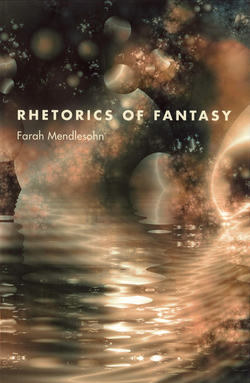Читать книгу Rhetorics of Fantasy - Farah Mendlesohn - Страница 16
На сайте Литреса книга снята с продажи.
The Liminal Fantasy
ОглавлениеThe liminal fantasy is perhaps the most interesting because it is so rare. M. John Harrison has spoken of the existence of the transliminal moment, the point where we are invited to cross the threshold into the fantastic, but choose not to do so.7 The result is that the fantastic leaks back through the portal. One such manifestation can be the leakage of the monster into the narrated world—Philip Pullman uses this motif to create horror in The Subtle Knife (1997)—more subtly, however, the portal itself may be the intrusion. Harrison notes this motif in Wells’s “The Door in the Wall” (1906), in which a man is three times tempted by a green door leading to a garden, and three times refuses the portal. While the metaphorical role of the green door may be significant to the critic, here its position as representative of the fantastic is more important. This seemingly ordinary story feels like fantasy. We somehow know that it is the fantastic. What I contend is that in this story the fantastic is the temptation framed by the door. The anxiety and the continued maintenance and irresolution of the fantastic becomes the locus of the “fantasy.” The liminal moment that maintains the anxiety around this material temptation assists the creation of the tone and mode that we associate with the fantastic: its presence is represented as unnerving, and it is this sense of the unnerving that is at the heart of the category I have termed liminal. I prefer liminal to Tzvetan Todorov’s hesitation or uncertainty, because I think that hesitation is only one strategy employed by these writers. Todorov’s (1973) concern with “the fantastic” as something distinct from fantasy means that his ideas are encompassed within this section but do not describe the whole. Liminal fantasy as discussed here is very clear that magic, or at least the possibility of magic, is part of the consensus reality, a position rather different from, but not in conflict with, Todorov’s more specific interests.
In the liminal fantasy we are given to understand, through cues to the familiar, that this is our world. When the fantastic appears, it should be intrusive, disruptive of expectation; instead, while the events themselves might be noteworthy and/or disruptive, their magical origins barely raise an eyebrow. We are disoriented. The enclosed nature of the immersive fantasy is absent: the hints and cues are missing. Yet, as in immersive fantasy, the protagonist demonstrates no surprise. It is the reaction to the fantastic that shapes this category, as well as the context of the fantasy.
The tone of the liminal fantasy could be described as blasé. An excellent example may be found in Joan Aiken’s Armitage family stories, in which the family all remain remarkably calm when unicorns appear on their lawn (“Yes, But Today is Tuesday” [1953]). The tone of Aiken’s work is matter-of-fact and casual; unlike James Thurber’s “The Unicorn in the Garden” (1940), it is not trying to trick anyone. The protagonist in M. John Harrison’s “I Did It” (2001) spends a great deal of time discussing why he put an axe in his head, and whether it looks good, but neither he, nor anyone else, questions the viability of its presence. While liminal fantasy casualizes the fantastic within the experience of the protagonist, it estranges the reader. The situation is odd, and it is our reaction to oddness that is being exploited. Whereas in the portal fantasy we ride with the protagonist, in the liminal fantasy we sit in the subconscious of the point of view character, quietly screaming, “But something is wrong,” a dream on the point of becoming lucid. While the intrusion fantasy is fascinated with the monster, the liminal fantasy wallows in ennui. To cross the portal is to confront the illusion, but confrontation (as we shall see in chapter 1) reduces rather than intensifies the fantastic. The transliminal moment, which brings us up to the liminal point and then refuses to cross the threshold, has much greater potential to generate fear, awe, and confusion—all intensely important emotions in the creation of the fantastic mode.
Liminal fantasy may rely on conscious exaggeration of the mimetic style. Indeed, in defiance of the conventional understanding of the fantastic as straight-faced, the effectiveness of this category may rest with its adoption of the ironic mode. It seems clear that this category is shaped as much by doubts and questions as by assertions. It is perhaps the most interesting, though also the most elusive, of the categories proposed here. The liminal fantasy relies on a number of different techniques, but central to its construction of the Absurd are (1) irony and equipoise, (2) the twisting of the metonymic/metaphorical structures of fantasy, and (3) a construction of a point of balance right at the edge of belief.
This kind of fantasy may be the most demanding of the four categories outlined here and the one that most requires for its effectiveness the understanding and subversion of our expectations of the fantastic. Of all the categories it is the one that depends most on my notion of multiple fuzzy sets. Far from being at the edge of genre, the least fantastical of texts, liminal fantasy is the fuzzy set supported by and between the other modes that I am discussing. Liminal fantasies distill the essence of the fantastic.
